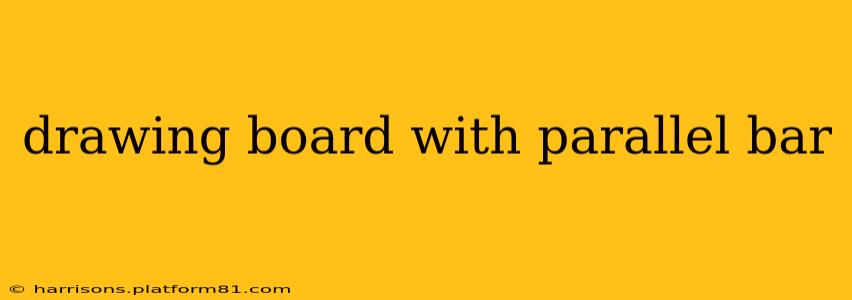A drawing board with parallel bars, often called a parallel motion drawing board or drafting board, is a precision instrument used for technical drawing, drafting, and design work. Its key feature—the parallel motion mechanism—ensures that the drawing head remains parallel to the drawing surface as it moves, preventing skewed lines and maintaining accuracy. This guide delves into the intricacies of these specialized boards, exploring their features, benefits, and applications.
What is a Parallel Motion Drawing Board?
A parallel motion drawing board utilizes a sophisticated system of bars and linkages to maintain the parallel movement of the drawing head. Unlike standard drawing boards where the angle of the drawing instrument changes as you move across the board, a parallel motion board ensures that your pen, pencil, or other drawing tool stays perfectly aligned with the surface, regardless of position. This is crucial for creating precise, accurate drawings.
How Does a Parallel Motion Drawing Board Work?
The mechanism hinges on a system of parallel bars, typically two or more, connected by pivots and linkages. As you move the drawing head across the board, these bars ensure that the head remains parallel to the baseline, preventing any tilting or skewing. The design's complexity varies depending on the manufacturer and the board's size and features. Higher-quality boards offer smoother, more precise movement.
What are the Benefits of Using a Parallel Motion Drawing Board?
The primary advantage is the unparalleled accuracy it offers. This precision is invaluable in various applications:
- Technical Drawing: Creating precise architectural, mechanical, or electrical drawings requires utmost accuracy, which parallel motion boards guarantee.
- Drafting: Detailing and drafting require consistently parallel lines, making these boards indispensable.
- Design Work: Whether designing clothing patterns, product layouts, or intricate illustrations, parallel motion boards contribute to superior accuracy and neatness.
What are the Different Types of Parallel Motion Drawing Boards?
Parallel motion drawing boards come in various sizes and configurations to suit different needs and preferences. Some key distinctions include:
- Size: Boards range from small, compact models suitable for personal use to large, heavy-duty boards used in professional settings.
- Material: They are typically made from sturdy materials such as wood or plastic, chosen for their durability and stability.
- Features: Some models incorporate additional features like adjustable angles, built-in storage for drawing tools, and specialized clamps.
What is the Best Parallel Motion Drawing Board for Beginners?
Choosing the best board depends on individual needs and budget. For beginners, a smaller, less expensive model may suffice. Focus on a board with smooth, easy-to-use parallel motion, and a stable, comfortable working surface. Reading reviews and comparing features from different manufacturers can help find a suitable option.
Where Can I Buy a Parallel Motion Drawing Board?
Parallel motion drawing boards can be purchased from various art supply stores, both online and brick-and-mortar. Specialized drafting supply retailers often carry a wider selection. Comparing prices and features across different vendors is recommended before making a purchase.
How Do I Clean and Maintain My Parallel Motion Drawing Board?
Regular cleaning is crucial for maintaining the board's performance and lifespan. Gently wipe the surface with a soft cloth and appropriate cleaning solution, avoiding harsh chemicals. Periodically inspect the parallel motion mechanism for any signs of wear or damage, ensuring smooth operation.
What are the Alternatives to a Parallel Motion Drawing Board?
While parallel motion boards provide unparalleled accuracy, alternatives exist, each with its own advantages and drawbacks:
- Standard Drawing Boards: More affordable but lack the precision of parallel motion boards.
- Digital Drawing Tablets: Offer flexibility and versatility but may not be suitable for all drafting applications.
- CAD Software: A popular digital alternative for creating highly accurate technical drawings.
This comprehensive guide provides a thorough understanding of parallel motion drawing boards. By understanding their features, benefits, and applications, you can make an informed decision about whether this specialized tool is suitable for your drawing needs.
